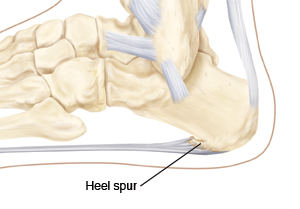The plantar fascia is a thick, fibrous layer of tissue that covers the bones on the bottom of your foot. It holds the foot bones in an arched position. Plantar fasciitis is a painful swelling of the plantar fascia.
A heel spur is an overgrowth of bone (calcium deposit) where the plantar fascia attaches to the heel bone. The heel spur itself usually doesn’t cause pain. But the heel spur might be a sign of plantar fasciitis, which may cause your foot pain.
Plantar fasciitis can develop slowly or suddenly. It usually affects 1 foot at a time. Heel pain can feel sharp, like a knife sticking into the bottom of your foot. You may feel pain after exercising, long-distance jogging, stair climbing, long periods of standing, or after standing up.
Risk factors for plantar fasciitis include arthritis, diabetes, obesity or recent weight gain, flat foot, and having high arches. Wearing high heels, loose shoes, or shoes with poor arch support adds to the risk.
Foot pain is usually worse in the morning. But it improves with walking. By the end of the day there may be a dull aching. Treatment includes short-term rest and controlling inflammation. It may take up to 10 months before all symptoms go away. But symptoms can improve in most people with plantar fasciitis in 2 months after initial treatment. In rare cases, you may need a steroid shot (injection) in your foot, or surgery.
Home care
-
Weight loss can help with healing if you're overweight.
-
Choose supportive shoes with good arch support and shock absorbency. Replace athletic shoes when they become worn out. Don't walk or run barefoot. Don't wear flat shoes.
-
Premade or custom-fitted shoe inserts may be helpful. Inserts made of silicone seem to be the most effective. Custom-made inserts can be provided by a foot specialist, physical therapist, or orthopedist.
-
Premade or custom-made night splints keep the heel stretched out while you sleep. They may prevent morning pain.
-
Don't do activities that stress the feet, such as jogging, prolonged standing or walking, or contact sports.
-
First thing in the morning and before sports, stretch the bottom of your foot. Gently flex your ankle so the toes move toward your knee.
-
Icing may help control heel pain. Apply an ice pack to the heel for 10 to 20 minutes 3 to 4 times a day to relieve symptoms. Or ice your heel after a severe flare-up of symptoms. To make an ice pack, put ice cubes in a plastic bag that seals at the top. Wrap the bag in a thin towel or cloth before using.
-
You may use over-the-counter pain medicine to control pain, unless another medicine was prescribed. Anti-inflammatory pain medicines, such as ibuprofen or naproxen, may work better than acetaminophen. If you have chronic liver or kidney disease, ever had a stomach ulcer or gastrointestinal bleeding or take blood thinners, talk with your health care provider before using these medicines.
-
Shoe inserts, a night splint, or a special boot may be needed. Use these as directed by your provider.
-
Stretching exercises to increase flexibility may be advised by a physical therapist to do at home.
Follow-up care
Follow up with your health care provider, physical therapist, or foot specialist as advised.
When to get medical advice
Contact your health care provider right away if either of these occur:
-
The pain gets worse.
-
There is no relief after a few weeks of home treatment.


